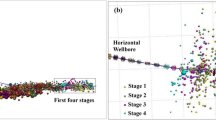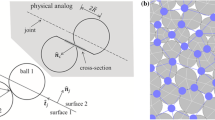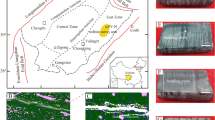Abstract
Shale formations are often characterized by low matrix permeability and contain numerous bedding planes (BPs) and natural fractures (NFs). Massive hydraulic fracturing is an important technology for the economic development of shale formations in which a large-scale hydraulic fracture network (HFN) is generated for hydrocarbon flow. In this study, HFN propagation is numerically investigated in a horizontally layered and naturally fractured shale formation by using a newly developed complex fracturing model based on the 3D discrete element method. In this model, a succession of continuous horizontal BP interfaces and vertical NFs is explicitly represented and a shale matrix block is considered impermeable, transversely isotropic, and linearly elastic. A series of simulations is performed to illustrate the influence of anisotropy, associated with the presence of BPs, on the HFN propagation geometry in shale formations. Modeling results reveal that the presence of BP interfaces increases the injection pressure during fracturing. HF deflection into a BP interface tends to occur under high strength and elastic anisotropy as well as in low vertical stress anisotropy conditions, which generate a T-shaped or horizontal fracture. Opened BP interfaces may limit the growth of the fracture upward and downward, resulting in a very low stimulated thickness. However, the opened BP interfaces favor fracture complexity because of the improved connection between HFs and NFs horizontally under moderate vertical stress anisotropy. This study may help predict the HF growth geometry and optimize the fracturing treatment designs in shale formations with complex depositional heterogeneity.


















Similar content being viewed by others
Abbreviations
- p :
-
Fluid pressure within the fracture
- p int :
-
Initial fluid pressure within the fracture
- μ :
-
Fluid dynamic viscosity
- Q t :
-
Total injection rate
- q :
-
Local flow rate within the fracture
- \(F_{\text{n}} ,\;F_{\text{s}}\) :
-
Normal and shear forces on a contact
- \(k_{\text{n}} ,\;k_{\text{s}}\) :
-
Normal and shear contact stiffness
- \(F_{\text{n}}^{\hbox{max} } ,\;F_{\text{s}}^{\hbox{max} }\) :
-
Tensile and shear bond strengths of a contact
- \(F_{\text{fric}}^{\text{s}}\) :
-
Friction force of a contact
- \(u_{\text{n}} ,\;u_{\text{s}}\) :
-
Normal and shear displacements
- \(\Delta u_{\text{n}} ,\;\Delta u_{\text{s}}\) :
-
Normal and shear displacement increments
- w :
-
Fracture aperture
- w res :
-
Fracture residual aperture
- \(\sigma_{ij}\) :
-
Cauchy stress tensor
- \(b_{i}\) :
-
Body force per unit volume
- \(u_{i,t} ,\;u_{i,tt}\) :
-
Velocity and acceleration
- \(\rho\) :
-
Rock density
- \(\alpha\) :
-
Damping coefficient
- D :
-
Elasticity tensor
- \(\varepsilon\) :
-
Strain tensor
- A :
-
Contact area
- \(G_{\text{v}}\) :
-
Shear modulus parallel to bedding plane
- \(E_{\text{h}} ,\;E_{\text{v}}\) :
-
Young’s moduli parallel and perpendicular to bedding plane
- \(\nu_{\text{h}} ,\;\nu_{\text{v}}\) :
-
Poisson’s ratios parallel and perpendicular to bedding plane
- \(T_{{0{\text{h}}}} ,\;T_{{0{\text{v}}}}\) :
-
Tensile strengths parallel and perpendicular to bedding plane
- \(S_{{0{\text{h}}}} ,\;S_{{0{\text{v}}}}\) :
-
Cohesions parallel and perpendicular to bedding plane
- \(\varphi_{{0{\text{h}}}} ,\;\varphi_{{0{\text{v}}}}\) :
-
Frictional angles parallel and perpendicular to bedding plane
- \(k_{\text{h}} ,\;k_{\text{v}}\) :
-
Permeability parallel and perpendicular to bedding plane
- \(k_{\text{nf}}\) :
-
Permeability of natural fracture
- \(T_{\text{nf}}\) :
-
Tensile strength of natural fracture
- \(S_{\text{nf}}\) :
-
Cohesion of natural fracture
- \(\varphi_{\text{nf}}\) :
-
Frictional angle of natural fracture
- \(\sigma_{{{\text{h}}\hbox{max} }} ,\;\sigma_{{{\text{h}}\hbox{min} }} \;{\text{and}}\;\sigma_{\text{v}}\) :
-
Maximum, minimum horizontal and vertical in situ stresses
- \(\Delta \sigma_{\text{h}} ,\;\Delta \sigma_{\text{v}}\) :
-
Horizontal and vertical stress anisotropies
- \(\theta\) :
-
Intersection angle between hydraulic fracture and natural fracture
References
Adachi J, Siebrits E, Peirce A, Desroches J (2007) Computer simulation of hydraulic fractures. Int J Rock Mech Min Sci 44(5):739–757
Batchelor GK (1967) An introduction to fluid dynamics. Cambridge University Press, Cambridge
Blanton TL (1986) Propagation of hydraulically and dynamically induced fractures in naturally fractured reservoirs. In: SPE/DOE Unconventional Gas Technology Symposium, Society of Petroleum Engineers
Bour O, Davy P, Darcel C (2002) A statistical scaling model for fracture network geometry, with validation on a multiscale mapping of a joint network. J Geophys Res 107(B6):ETG 4-1–ETG 4-12
Cooke ML, Underwood CA (2001) Fracture termination and step-over at bedding interfaces due to frictional slip and interface opening. J Struct Geol 23(2–3):223–238
Dahi-Taleghani A, Olson JE (2009) Numerical modeling of multi-stranded hydraulic fracture propagation: accounting for the interaction between induced and natural fractures. SPE J 16(3):575–581
Dahi-Taleghani A, Olson JE (2014) How natural fractures could affect hydraulic-fracture geometry. SPE J 19(1):161–171
Dershowitz WS, Einstein HH (1988) Characterizing rock joint geometry with joint system models. Rock Mech Rock Eng 21(1):21–51
Fisher K, Warpinski NR (2012) Hydraulic fracture height growth: real data. In: SPE Annual Technical Conference and Exhibition, Society of Petroleum Engineers
Fisher MK, Davidson BM, Goodwin AK, Fielder EO, Buckler WS, Steinsberger NP (2002) Integrating Fracture mapping technologies to optimize stimulations in the Barnett shale. In: SPE Annual Technical Conference and Exhibition, Society of Petroleum Engineers
Gale JFW, Reed RM, Holder J (2007) Natural fractures in the Barnett shale and their importance for hydraulic fracture treatments. AAPG Bull 91(4):603–622
Geertsma J, de Klerk F (1969) A rapid method of predicting width and extent of hydraulically induced fractures. J Pet Technol 21:1571–1581
Grasselli G, Lisjak A, Omid K, Mahabadi OK, Tatone BSA (2015) Influence of pre-existing discontinuities and bedding planes on hydraulic fracturing initiation. Eur J Environ Civ Eng 19(5):580–597
Gu H, Weng X, Lund JB, Mack GM, Ganguly U, Suarez-Rivera R (2011) Hydraulic fracture crossing natural fracture at non orthogonal angles, a criterion, its validation and applications. In: SPE Hydraulic Fracturing Technology Conference, Society of Petroleum Engineers
Guo TK, Zhang SC, Qu ZQ, Zhou T, Xiao YS, Gao J (2014) Experimental study of hydraulic fracturing for shale by stimulated reservoir. Fuel 128:373–380
Hamidi F, Mortazavi A (2014) A new three dimensional approach to numerically model hydraulic fracturing process. J Pet Sci Eng 124:451–467
Hanson ME, Ronald J, Shaffer RJ, Anderson GD (1981) Effects of various parameters on hydraulic fracturing geometry. SPE J 21(4):435–443
Itasca Consulting Group Inc. (2014) UDEC (universal distinct element code), version 6.0 ICG. Itasca, Minneapolis
Jaeger JC, Cook NGW, Zimmerman RW (2007) Fundamental of rock mechanics, 4th edn. Blackwell Publishing Ltd, Hoboken
Kazerani T, Zhao J (2010) Micromechanical parameters in bonded particle method for modelling of brittle material failure. Int J Numer Anal Methods Geomech 34(18):1877–1895
Lekhnitskii SG (1981) Theory of elasticity of an anisotropic body. Mir Publishers, Moscow
Lisjak A, Grasselli G (2014) A review of discrete modeling techniques for fracturing processes in discontinuous rock masses. J Rock Mech Geotech Eng 6(4):301–314
Meyer BR, Bazan LW (2011) A discrete fracture network model for hydraulically-induced fractures: theory, parametric and case studies. In: SPE Hydraulic Fracturing Conference and Exhibition, Society of Petroleum Engineers
Mokhtari M, Bui BT, Azra N (2014) Tensile failure of shales: impacts of layering and natural fractures. In: SPE Western North American and Rocky Mountain Joint Meeting, Society of Petroleum Engineers
Nagel NB, Sanchez-Nagel MA, Zhang F, Garcia X, Lee B (2013) Coupled numerical evaluations of the geomechanical interactions between a hydraulic fracture stimulation and a natural fracture system in shale formations. Rock Mech Rock Eng 46(3):581–609
Nasehi MJ, Mortazavi A (2013) Effects of in-situs tress regime and intact rock strength parameters on the hydraulic fracturing. J Pet Sci Eng 108:211–221
Nordren RP (1972) Propagation of a vertical hydraulic fracture. SPE J 12(4):306–314
Olson JE (2008) Multi-fracture propagation modeling: applications to hydraulic fracturing in shales and tight gas sands. In: ARMA US Rock Mechanics Symposium
Olson JE, Dahi-Taleghani A (2009) Modeling simultaneous growth of multiple hydraulic fractures and their interaction with natural fractures. In: SPE Hydraulic Fracturing Technology Conference, Society of Petroleum Engineers
Perkins TK, Kern LR (1961) Widths of hydraulic fractures. J Pet Technol 13(9):937–949
Rutledge J, Yu X, Leaney S, Bennett L, Maxwell S (2014) Microseismic shearing generated by fringe cracks and bedding-plane slip. In: SEG Annual Meeting, Society of Exploration Geophysicists. https://www.onepetro.org/conference-paper/SEG-2014-0896
Suarez-Rivera R, Burghardt J, Stanchits S, Edelman E, Surdi A (2013) Understanding the effect of rock fabric on fracture complexity for improving completion design and well performance. In: SPE International Petroleum Technology Conference, Society of Petroleum Engineers
Thiercelin M, Roegiers JC, Boone TJ, Ingraffea AR (1987) An investigation of the material parameters that govern the behavior of fractures approaching rock interfaces. In: 6th International Congress of Rock Mechanics, International Society for Rock Mechanics
Warpinski NR, Teufel LW (1987) Influence of geologic discontinuities on hydraulic fracture propagation. J Pet Technol 39(2):209–220
Warpinski NR, Kramm RC, Heinze JR, Waltman CK (2005) Comparison of single- and dual-array microseismic mapping techniques in the Barnett shale. In: SPE Annual Technical Conference and Exhibition, Society of Petroleum Engineers
Waters GA, Lewis RE, Bentley DC (2011) The effect of mechanical properties anisotropy in the generation of hydraulic fractures in organic shales. In: SPE Annual Technical Conference and Exhibition, Society of Petroleum Engineers
Weng X (2015) Modeling of complex hydraulic fractures in naturally fractured formation. J Unconv Oil Gas Resour 9:115–134
Weng X, Kresse O, Cohen C (2011) Modeling of hydraulic fracture network propagation in a naturally fractured formation. In: SPE Hydraulic Fracturing Technology Conference and Exhibition, Society of Petroleum Engineers
Xu W, Thiercelin M, Ganguly U (2010) Wiremesh: a novel shale fracture simulator. In: CPS/SPE International Oil and Gas Conference and Exhibition, Society of Petroleum Engineers
Yew CH (1997) Mechanics of hydraulic fracturing. Gulf Professional Publishing, Houston, pp P25–P32
Zhang X, Jeffrey RG (2012) Fluid-driven multiple fracture growth from a permeable bedding plane intersected by an ascending hydraulic fracture. J Geophys Res 117:B12402
Zhang X, Jeffrey RG, Thiercelin M (2007) Deflection and propagation of fluid-driven fractures at frictional bedding interfaces: a numerical investigation. J Struct Geol 29(3):396–410
Zhao Q, Lisjak A, Mahabadi O, Liu Q, Grasselli G (2014) Numerical simulation of hydraulic fracturing and associated microseismicity using finite-discrete element method. J Rock Mech Geotech Eng 6:574–581
Zimmerman RW, Bodvarsson GS (1996) Hydraulic conductivity of rock fractures. Transp Porous Media 23:1–30
Zou YS, Zhang SC, Zhou T, Zhou GT (2016) Experimental investigation into hydraulic fracture network propagation in gas shales using CT scanning technology. Rock Mech Rock Eng 49(1):33–45
Acknowledgments
This paper was supported by the Major National Science and Technology Projects of China (No. 2015CB250903) and the National Basic Research Program of China (No. 2013CB228004).
Author information
Authors and Affiliations
Corresponding author
Rights and permissions
About this article
Cite this article
Yushi, Z., Xinfang, M., Shicheng, Z. et al. Numerical Investigation into the Influence of Bedding Plane on Hydraulic Fracture Network Propagation in Shale Formations. Rock Mech Rock Eng 49, 3597–3614 (2016). https://doi.org/10.1007/s00603-016-1001-5
Received:
Accepted:
Published:
Issue Date:
DOI: https://doi.org/10.1007/s00603-016-1001-5




